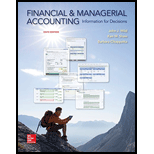
1.
To identify: Break- even point of sales in dollars (a) plan 1 and (b) plan 2.
1.
Explanation of Solution
(a)
Plan 1
Given,
Fixed cost is $525,000
Calculated values,
Contribution margin ratio is 70% or 0.7 (from working note).
Formula to calculate break-even point of sales in dollars,
Substitute $525,000 for fixed cost and 0.7 for contribution margin ratio.
Working note:
Given,
Material cost is $8.
Labor cost is $5.
Material cost reduced by 50%.
Labor cost reduced by 60%.
Calculation of new material cost,
Hence, material cost is $4.
Calculation of new labor cost,
Hence, labor cost is $2.
Calculation of total variable cost,
Calculation of contribution margin,
Compute contribution margin ratio.
Given,
Per unit selling price is $25.
Calculated values,
Unit contribution is $17.50.
Formula to calculate contribution margin ratio,
Hence, contribution margin ratio is 40%.
Plan 2
Given,
Fixed cost is $525,000
Calculated values,
Contribution margin ratio is 51.67% or 0.5167 (from working note).
Formula to calculate break-even point of sales in dollars,
Substitute $525,000 for fixed cost and 0.5167 for contribution margin ratio.
Working note:
Given,
Selling price is $25.
Selling price increased by 20%.
Volume of sales is 40,000.
Reduction in volume of sales is 10%.
Calculation of new selling price,
Calculation of new sales volume,
Calculation of contribution margin,
Compute contribution margin ratio.
Given,
Per unit selling price is $30.
Calculated values,
Unit contribution is $15.50.
Formula to calculate contribution margin ratio,
Hence, contribution margin ratio is 51.67%.
Hence, break-even point of sale of plan 1 and plan 2 is $750,000 and $ 700,000.
2.
To prepare: A contribution margin income statement for the company.
2.
Explanation of Solution
Statement to show the contribution margin income statement
| Company B | ||
| Income Statement | ||
| For the Year Ended December…. | ||
| Particulars | Plan 1 ($) | Plan 2 ($) |
| Sales | 1,000,000 | 1,080,000 |
| Less: Variable Cost | 300,000 | 522,000 |
| Contribution Margin | 700,000 | 558,000 |
| Less: Fixed Cost | 525,000 | 525,000 |
| Pre Tax Income | 175,000 | 33,000 |
| Tax | 52,500 | 9,900 |
| Net Income | 122,500 | 23,100 |
Table(1)
Working note:
Plan 1
Given,
The numbers of units sold is 40,000.
The selling price is $25.
Variable cost per unit is $17.50.
Calculation of total sales,
The total sales are $1,000,000.
Calculation of total variable cost,
The total variable cost is $700,000.
Calculation of tax,
Plan 2
Given,
The numbers of units sold is 36,000.
The selling price is $30.
Variable cost per unit is $14.50.
Calculation of total sales,
The total sales are $1,080,000.
Calculation of total variable cost,
The total variable cost is $522,000.
Calculation of tax,
Hence, the net income of Company B through plan 1 and plan 2 is $122,500 and $23,100.
Want to see more full solutions like this?
Chapter 18 Solutions
Financial and Managerial Accounting: Information for Decisions
- Can you solve this general accounting problem using accurate calculation methods?arrow_forwardCan you explain this financial accounting question using accurate calculation methods?arrow_forwardCan you provide the accurate answer to this financial accounting question using correct methods?arrow_forward
- Please provide the answer to this general accounting question using the right approach.arrow_forwardI am looking for help with this financial accounting question using proper accounting standards.arrow_forwardI need assistance with this financial accounting problem using appropriate calculation techniques.arrow_forward
- Please provide the correct answer to this financial accounting problem using accurate calculations.arrow_forwardCan you provide the accurate answer to this financial accounting question using correct methods?arrow_forwardCan you solve this financial accounting problem with appropriate steps and explanations?arrow_forward

 AccountingAccountingISBN:9781337272094Author:WARREN, Carl S., Reeve, James M., Duchac, Jonathan E.Publisher:Cengage Learning,
AccountingAccountingISBN:9781337272094Author:WARREN, Carl S., Reeve, James M., Duchac, Jonathan E.Publisher:Cengage Learning, Accounting Information SystemsAccountingISBN:9781337619202Author:Hall, James A.Publisher:Cengage Learning,
Accounting Information SystemsAccountingISBN:9781337619202Author:Hall, James A.Publisher:Cengage Learning, Horngren's Cost Accounting: A Managerial Emphasis...AccountingISBN:9780134475585Author:Srikant M. Datar, Madhav V. RajanPublisher:PEARSON
Horngren's Cost Accounting: A Managerial Emphasis...AccountingISBN:9780134475585Author:Srikant M. Datar, Madhav V. RajanPublisher:PEARSON Intermediate AccountingAccountingISBN:9781259722660Author:J. David Spiceland, Mark W. Nelson, Wayne M ThomasPublisher:McGraw-Hill Education
Intermediate AccountingAccountingISBN:9781259722660Author:J. David Spiceland, Mark W. Nelson, Wayne M ThomasPublisher:McGraw-Hill Education Financial and Managerial AccountingAccountingISBN:9781259726705Author:John J Wild, Ken W. Shaw, Barbara Chiappetta Fundamental Accounting PrinciplesPublisher:McGraw-Hill Education
Financial and Managerial AccountingAccountingISBN:9781259726705Author:John J Wild, Ken W. Shaw, Barbara Chiappetta Fundamental Accounting PrinciplesPublisher:McGraw-Hill Education





